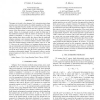Free Online Productivity Tools
i2Speak
i2Symbol
i2OCR
iTex2Img
iWeb2Print
iWeb2Shot
i2Type
iPdf2Split
iPdf2Merge
i2Bopomofo
i2Arabic
i2Style
i2Image
i2PDF
iLatex2Rtf
Sci2ools
ICASSP
2009
IEEE
2009
IEEE
Improved subspace DoA estimation methods with large arrays: The deterministic signals case
This paper is devoted to the subspace DoA estimation using a large antennas array when the number of available snapshots is of the same order of magnitude than the number of sensors. In this context, the traditional subspace methods fail because the empirical covariance matrix of the observations is a poor estimate of the true covariance matrix. Mestre et al. proposed recently to study the behaviour of the traditional estimators when the number of antennas M and the number of snapshots N converge to +∞ at the same rate. Using large random matrix theory results, they showed that the traditional subspace estimate is not consistent in the above asymptotic regime and they proposed a new consistent subspace estimate which outperforms the standard subspace method for realistic values of M and N. However, the work of Mestre et al. assumes that the source signals are independent and identically distributed in the time domain. The goal of the present paper is to propose new consistent estima...
| Added | 21 May 2010 |
| Updated | 21 May 2010 |
| Type | Conference |
| Year | 2009 |
| Where | ICASSP |
| Authors | Pascal Vallet, Philippe Loubaton, Xavier Mestre |
Comments (0)

